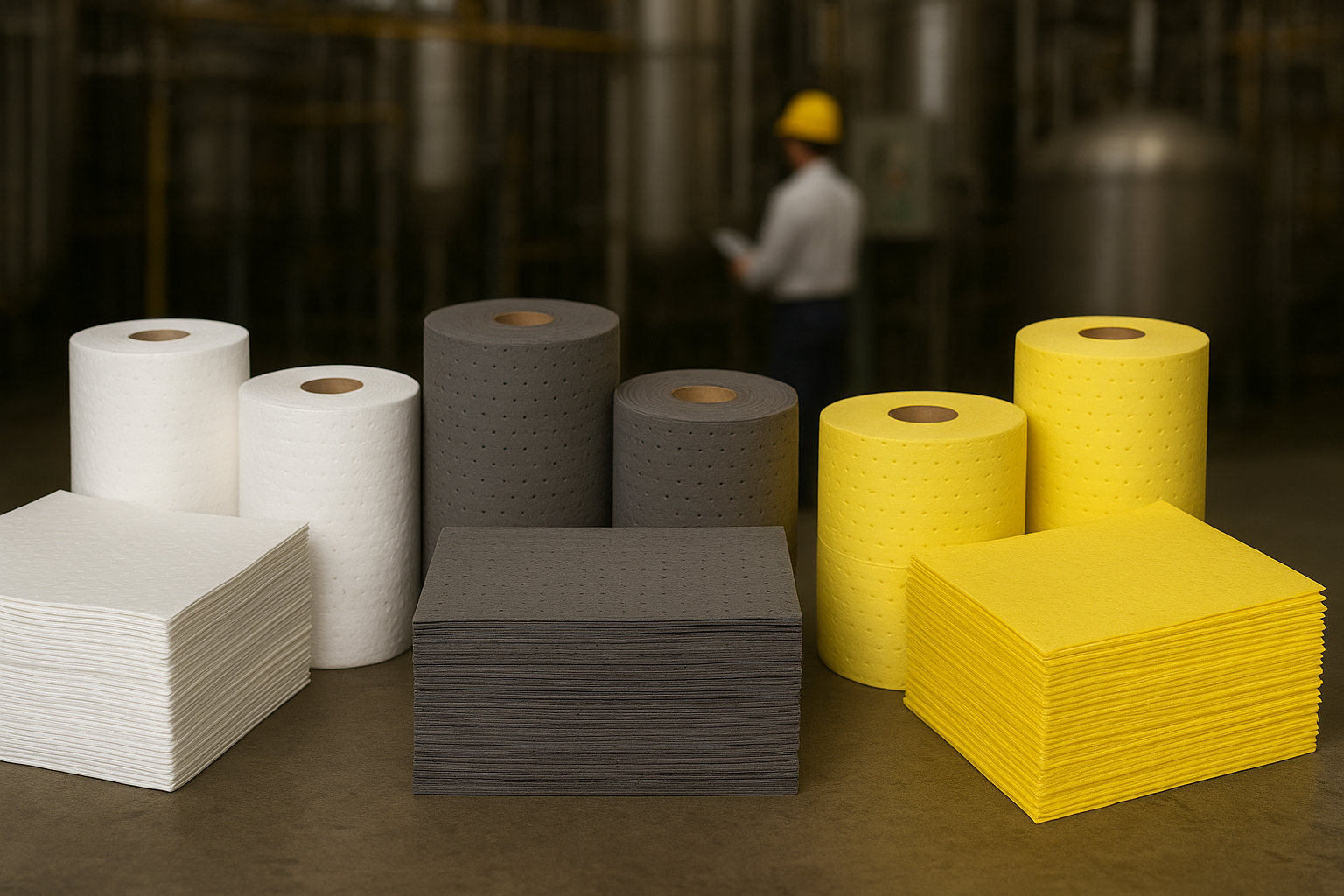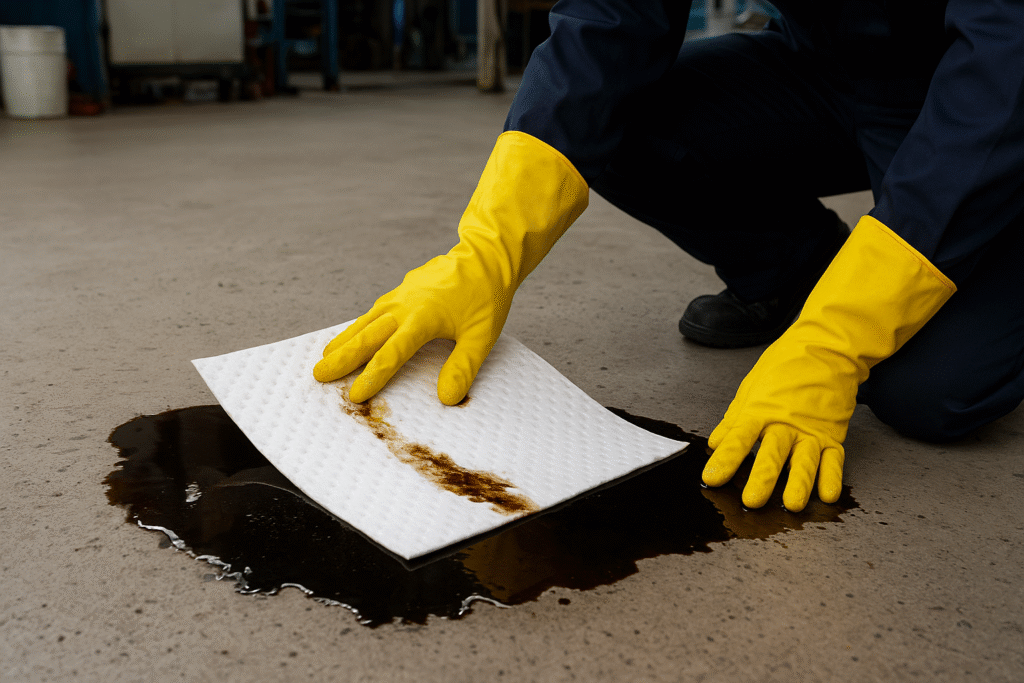
Spills rarely send a warning before they happen. Imagine this: a busy workshop floor, machines humming, workers moving quickly and suddenly, a container tips over, sending oil spreading across the surface. Within seconds, the small mishap becomes a major hazard. Workers are at risk of slipping, machinery could get damaged and the clock starts ticking on lost productivity.
In situations like this, the first line of defense isn’t just quick thinking, it’s having the right absorbent pads at hand.
Why Absorbent Pads Matter
Accidental spills: whether oil, coolants, chemicals, or water, pose serious safety and environmental challenges. Left unmanaged, they can cause contamination, create hazardous working conditions and lead to regulatory fines. Absorbent pads are designed to tackle these exact scenarios, ensuring quick and effective cleanup. But here’s the catch: not all absorbent pads are created equal.

The Three Main Types of Absorbent Pads
1. Oil-Only Absorbent Pads
These pads are engineered to repel water and soak up only oils and hydrocarbons such as gasoline, diesel and lubricants. Perfect for marine environments, harbors and oil rigs, they float on water while pulling in oil, making them an essential tool in any spill response kit.
Best For: Oil spills near water, machinery leaks, harbors, and marine operations. You can check the product here.
2. Universal or General Purpose Absorbent Pads
Known as the all-rounders of spill control, universal/general purpose pads can handle both oil and water-based liquids like coolants, solvents or mild chemicals. Made from polypropylene, they’re the most versatile option for workplaces where spills vary day to day.
Best For: Factories, warehouses, and workshops with a mix of oils, chemicals, and water spills. You can explore the products here.
3. Chemical Absorbent Pads
When dealing with hazardous or aggressive liquids, universal pads aren’t enough. Chemical absorbent pads are designed to safely soak up strong acids, bases and unknown liquids without breaking down. Their bright yellow color often makes them easy to identify in emergencies.
Best For: Laboratories, chemical plants, and industrial facilities handling corrosive or dangerous liquids. Browse the products here.
Factors to Consider Before Choosing
It’s not just about the type of pad, you also need to think about:
- Spill type: Oil near water calls for oil-only pads; strong chemicals require chemical pads.
- Spill size: For larger spills, go for high-capacity pads to prevent oversaturation.
- Work environment: Outdoor or rough surfaces need heavy-duty, tear-resistant pads.
The Value of Choosing Right
The correct absorbent pads don’t just clean up messes, they protect your business. They reduce cleanup time, minimize costs and prevent waste. Most importantly, they keep your workplace safe and help you stay compliant with environmental and safety regulations.
Common Mistakes to Avoid
Even with the right tools, some errors can make spill control less effective. Watch out for:
✅ Using universal pads for oil spills on water.
✅ Ignoring chemical-specific pads when working with hazardous liquids.
✅ Underestimating how much liquid a spill can produce.
✅ Poor storage, making pads hard to access during emergencies.
FAQs on Absorbent Pads
1. Can I use universal pads for oil spills on water?
Not effectively. Universal pads absorb both oil and water, so they quickly become saturated. For oil-on-water spills, oil-only absorbent pads are the best choice since they repel water.
2. How do chemical absorbent pads differ from general purpose ones?
Chemical pads are specially designed to handle corrosive or hazardous liquids, such as strong acids or bases. Universal/general purpose pads can’t withstand these aggressive substances and may break down.
3. How often should I replace my stock of absorbent pads?
Check your inventory regularly and rotate pads every 12–18 months to ensure they remain effective, especially if stored in humid or outdoor environments.
4. Are absorbent pads reusable?
Most absorbent pads are single-use to ensure safety and maximum absorption. Reusing them can reduce effectiveness and pose contamination risks.
5. Where should I store absorbent pads in my facility?
Place them in accessible locations: near machinery, storage areas and any high-risk zones. In emergencies, easy access makes all the difference.
Final Thoughts
Choosing the right absorbent pad can mean the difference between a quick recovery and a costly disaster. Oil-only pads are perfect for hydrocarbons, universal pads give versatility in mixed environments and chemical absorbent pads provide critical safety against hazardous spills.
Be prepared, store pads strategically, and rotate your stock regularly to ensure maximum effectiveness when accidents strike.
Explore our full range of absorbent pads here:
👉 Absorbent Pads – Ocean Safety Supplies

